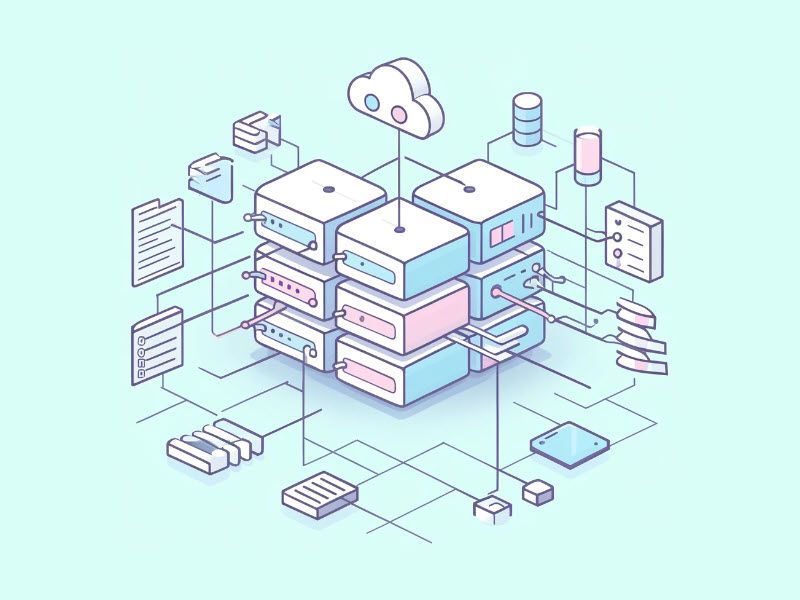Chaos engineering is often misunderstood as randomly breaking things in a system. However, it is a structured and deliberate practice that involves setting up and evaluating controlled failures rather than causing chaos.
In this article, we will break down what chaos engineering is and how you can use it to make your systems tougher and more dependable.
What Is Chaos Engineering?
Chaos engineering is the practice of intentionally introducing failures into a system to test its resilience and observe its behavior under stress. This discipline identifies weaknesses and improves system reliability across the entire organizational spectrum by simulating real-world conditions and unexpected disruptions.

How Does Chaos Engineering Work?
Chaos engineering begins with identifying the normal operating conditions of the system, known as the "steady state." Engineers then formulate hypotheses about how the system should respond to specific failures or disruptions. With these hypotheses in mind, they design and execute experiments that introduce faults such as server crashes, network latency, or resource exhaustion.
During these experiments, the system’s performance is closely monitored to observe its response. The focus is on understanding how the disruptions impact the system and identifying any unexpected behaviors or weaknesses. This real-time observation helps pinpoint areas where the system is vulnerable.
After the experiments, the insights gained are analyzed to determine what went wrong and why. Based on these findings, improvements are made to enhance the system’s resilience. The iterative process of testing, observing, and refining helps build a more robust infrastructure capable of withstanding real-world challenges.
Chaos Engineering Principles
Chaos Engineering works through a systematic process of deliberately introducing disruptions and observing the outcomes. Here are the key steps involved:
1. Define the Steady State
Begin by establishing a baseline of the system's normal operations and determine key performance indicators (KPIs) that reflect this. These metrics could include response times, error rates, throughput, and other relevant performance indicators. Understanding and documenting normal operating conditions helps organizations to create a reference point for comparison during chaos experiments.
2. Formulate Hypotheses
Develop hypotheses about how the system will respond to specific types of disruptions and set expectations for the experiments. For example, if a database node fails, the system will continue to handle user requests without noticeable degradation in performance.
3. Plan Experiments
Create a detailed plan for introducing failures into the system. This might involve shutting down servers, introducing network latency, simulating hardware failures, etc. Choose specific components or services to be targeted by the experiment. These should be critical to the system’s operation to provide valuable insights.
4. Execute Experiments
Implement the planned disruptions by using appropriate tools and frameworks to inject failures into the system. Observe the system’s performance and behavior during the experiment with monitoring tools and logging frameworks.
5. Analyze Results
Analyze the differences in the system's behavior against the steady-state metrics to see how it coped with the introduced faults. Determine what went wrong, why it went wrong, and what can be improved. Look for unexpected behavior, performance degradation, and failure cascades.
6. Improve and Iterate
Based on the findings, make necessary improvements to the system’s architecture, configuration, or code. Continuously perform experiments as part of the development and deployment cycle to ensure ongoing resilience and to adapt to new potential failure modes as the system evolves.

Types of Chaos Engineering Tests
Here are some common types of Chaos Engineering tests:
- Infrastructure failure tests. Simulate failures in the underlying infrastructure to see how the system handles disruptions in essential resources. For instance, randomly terminating instances or virtual machines tests the system's ability to handle a sudden loss of computing resources, ensuring the infrastructure can recover smoothly.
- Application failure tests. Forcefully shutting down critical services helps you understand how the system manages issues within the software. This type of test can identify single points of failure and improve the overall resilience of the application by testing its response to the loss of key functionalities.
- Dependency failure tests. Target external software dependencies to assess how the system handles failures in third-party services. For example, you can simulate a database crash or connectivity issue to observe how the application handles data unavailability.
- Network failure tests. Introduce network-related issues to examine the system's robustness in maintaining connectivity and data flow. For example, you can add artificial latency to network communications to test the system's tolerance to delays.
- Security chaos engineering tests. Assess the system's response to cyber attacks and vulnerabilities. Examples include simulations of unauthorized access attempts to test the system's ability to detect and respond to data breaches, as well as DDoS attack simulations to evaluate the system's capacity to withstand high traffic volumes.
- Operational failure tests. Ensure the system can handle routine maintenance and unexpected operational issues. For example, you can simulate deployment failures to assess the system's ability to roll back changes and recover gracefully.

Benefits of Chaos Engineering
Here are the key advantages of chaos engineering:
- Increased system resilience. Intentionally introducing failures allows teams to address vulnerabilities before they cause significant issues in production, increasing the system's overall resilience to real-world disruptions.
- Improved incident response and disaster recovery. Simulating failures and practicing responses develops effective incident management strategies, improves communication, and reduces the time to recovery during real outages.
- Proactive problem identification. Instead of waiting for issues to occur in production, chaos engineering allows teams to proactively discover and fix problems.
- Validation of redundancy and failover procedures. Chaos engineering tests the effectiveness of redundancy and failover mechanisms.
- Enhanced security. Security-related chaos engineering tests identify and address weaknesses before hackers can exploit them.
- Better preparedness for scaling. Chaos engineering helps identify how the system behaves under varying loads and stress conditions. This knowledge is crucial for planning and managing system scalability, ensuring that the system can handle increased demand without compromising performance.

Chaos Engineering Challenges
Here are some of the key challenges of chaos engineering:
- Risk of disruption. Despite being controlled, chaos engineering experiments can still lead to unintended disruptions, especially in production environments.
- Monitoring and observability. Effective chaos engineering relies heavily on monitoring and observability. Organizations must have comprehensive solutions in place to capture detailed metrics and logs.
- Data management. Analyzing the results of experiments generates a significant amount of data. Managing, storing, and analyzing this data to extract actionable insights is a challenging task.
- Resource allocation. Dedicating time and resources to chaos engineering is a trade-off against immediate development and operational needs.
- Skill set requirements. Chaos engineering experiments require specialized skills to design, execute, and analyze. Training and developing these skills within the team, or hiring specialists, can be a barrier for some organizations.

Chaos Engineering Use Cases Explained
Here are the use cases for chaos engineering.
Improving System Reliability
Here are ways to improve system reliability with chaos engineering:
Cloud Infrastructure Resilience Tests
Testing the resilience of cloud infrastructure ensures it can handle disruptions.
- Instance termination. Simulate random termination of virtual machines or instances to test the cloud infrastructure's ability to handle unexpected resource loss.
- Region failover. Test the system's ability to handle failover between different geographical regions in a cloud environment.
Microservices Architecture Testing
Microservices architecture benefits from understanding how services interact and tolerate failures.
- Service shutdown. Shut down individual microservices to observe how the system handles the loss of specific components.
- Network latency. Introduce network latency between microservices to test the system's tolerance to communication delays.
Database Failures Tests
Database failures are critical scenarios to test for ensuring data availability and application performance.
- Database crash. Simulate a database crash to test how the application handles data unavailability.
- Connection pool exhaustion. Introduce scenarios in which the database connection pool is exhausted to observe the application's response.
Ensuring Operational Continuity
Here are some methods to ensure operational continuity:
Network Infrastructure Testing
Network-related tests focus on maintaining data integrity and performance under adverse conditions.
- Packet loss. Simulate packet loss to test the system's robustness in maintaining data integrity.
- Bandwidth throttling. Reduce network bandwidth to see how the system performs under constrained network conditions.
Deployment and Release Testing
Testing deployment and release processes ensures smooth and reliable updates to your systems.
- Canary deployments. Test the impact of deploying new software versions in a controlled manner to ensure stability before a full rollout.
- Rollback mechanisms. Simulate deployment failures to validate the effectiveness of rollback mechanisms and ensure smooth recovery.
Backup and Disaster Recovery Testing
Testing backup and disaster recovery ensures data integrity and system availability during catastrophic events.
- Data loss. Simulate data loss scenarios to test the effectiveness of backup and restore processes.
- Disaster recovery drills. Conduct drills to ensure the system can recover from catastrophic failures and validate disaster recovery plans.
Enhancing User Experience and Compliance
Improving user experience (UX) and ensuring compliance are essential for maintaining trust and meeting regulatory requirements. Here are some ways to enhance user experience and ensure compliance:
User Experience Testing
Simulating user conditions helps ensure a reliable and satisfactory user experience.
- Load testing. Simulate high user loads to test the system's scalability and performance under peak conditions.
- Service degradation. Introduce controlled service degradation to understand its impact on user experience and identify areas for improvement.
Compliance and Regulatory Testing
Ensuring compliance and regulatory adherence involves testing data privacy and logging mechanisms.
- Data privacy violations. Simulate scenarios where data privacy policies are violated to test compliance mechanisms and response strategies.
- Audit logging. Ensure audit logging systems capture all necessary information during chaos experiments to comply with regulatory requirements.
Test-Driven Development (TDD) focuses on writing tests before the code, ensuring that each piece of functionality is verified through unit tests. Behavior-Driven Development (BDD) extends TDD by specifying the behavior of the software in a more readable, user-centric language, often involving collaboration between developers, testers, and business stakeholders.
Read our article on TDD vs. BDD for a detailed overview and comparison.

Chaos Engineering Tools
Chaos engineering tools are software applications and platforms designed to facilitate the practice of chaos engineering. These tools help automate and manage the process of injecting failures and monitoring the system's response. Here are the most prominent chaos engineering tools:
Chaos Monkey
Chaos Monkey is a tool developed by Netflix to randomly terminate instances in a production environment, helping to ensure that the system can withstand unexpected failures.
Pros:
- Easy to set up and integrate with existing AWS environments.
- Widely used and tested within Netflix’s own infrastructure.
Cons:
- Primarily focuses on instance termination, which doesn’t cover all failure scenarios.
- Designed specifically for AWS, limiting its applicability to other cloud providers or on-premises systems.
Pricing:
- Free and open source.
Gremlin
Gremlin is a comprehensive chaos engineering platform that allows users to simulate various types of failures, including CPU spikes, network latency, and more.
Pros:
- Supports a wide range of failure types and scenarios.
- Offers a user-friendly graphical user interface (GUI) that simplifies creating and managing chaos experiments.
Cons:
- Can be expensive for smaller organizations due to its subscription-based pricing model.
- Requires a learning period to fully utilize its advanced features and capabilities.
Pricing:
- Subscription-based model with custom enterprise pricing.
Litmus
Litmus is an open-source chaos engineering tool for Kubernetes, designed to help users identify weaknesses in their containerized applications.
Pros:
- Seamlessly integrates with Kubernetes environments, providing native support for containerized applications.
- Has an active community contributing to improvements and feature additions.
Cons:
- Limited to Kubernetes, making it less useful for non-containerized applications.
- Complex initial setup and configuration, especially for users new to Kubernetes.
Pricing:
- Litmus is open source and free.
Chaos Toolkit
Chaos Toolkit is an open-source tool that provides a simple, extensible framework for running chaos experiments on various platforms.
Pros:
- Easily extendable with plugins to support different platforms and failure scenarios.
- Free to use and supported by a community of developers.
Cons:
- Requires additional plugins and extensions to support more complex experiments.
- Chaos Toolkit lacks a graphical interface, relying on command-line operations, which may be less intuitive for some users.
Pricing:
- Open source and free.
Pumba
Pumba is an open-source chaos testing tool specifically designed for Docker containers, allowing users to simulate various types of container failures.
Pros:
- Provides a straightforward way to introduce failures in Docker environments.
- Minimal resource overhead, making it suitable for testing on resource-constrained environments.
Cons:
- Limited to Docker, which may not be suitable for users with a diverse infrastructure.
- Offers fewer features compared to more comprehensive chaos engineering platforms.
Pricing:
- Open source and free.

Chaos Engineering: Best Practices
Implementing chaos engineering requires following best practices that ensure controlled, meaningful, and safe experiments.
- Ensure comprehensive monitoring and observability. Robust monitoring and observability tools ensure chaos tests reveal new insights rather than obvious outcomes.
- Start small and gradually increase scope. Start with small, contained experiments to minimize risk and gain confidence. As your team becomes more comfortable with chaos engineering, gradually increase the scope and complexity of the experiments.
- Prioritize production environments. Chaos experiments should ideally be conducted in production environments to closely mimic real-world conditions. If risk tolerance is low, starting in pre-production environments can help you build confidence. However, the goal should be to gradually move to production as confidence in the experiments grows.
- Involve all stakeholders. Chaos engineering is most effective when it involves collaboration across different teams. Encourage participation from development, operations, and security teams to gain diverse insights and improve overall system resilience.
- Avoid causing unintended disruptions. To be safe, implement mechanisms to quickly roll back and mitigate issues.
- Communicate findings and actions. Communicate the results and lessons learned from chaos experiments to all stakeholders. Provide clear, actionable insights and recommendations based on the findings.
- Document and analyze results. Record the setup, execution, and outcomes of each experiment. Thorough documentation and analysis of each experiment are essential for learning and improvement will help you understand the impact of disruptions and plan future experiments.

Chaos Engineering Implementation
Many businesses struggle to harness the full potential of chaos experiments. Here are some tips to help you get on the right track.
- Automate your testing. Manual chaos experiments are unsustainable and labor-intensive. Automation builds resilience into systems and achieves high development velocity, particularly in distributed systems.
- Adopt a blameless culture. When mistakes happen, avoid finger-pointing. Reflect on errors to understand their root causes and how to prevent them in the future. Embrace a transparent and open approach to failure analysis.
- Enhance system observability. No system is entirely reliable, and predicting all possible failures is impossible. Enhance your ability to diagnose and understand failures by improving system observability. Use monitoring tools to track steady states and identify changes during issues. These tools also facilitate automated chaos experiments in containerized applications.
- Balance frequency and impact. Finding the right frequency for running experiments is crucial. Too frequent tests lead to fatigue and potential system overloading, while infrequent tests do not provide sufficient insights.
- Define the scope and objectives. Determining the scope of experiments and setting clear objectives is difficult. You must balance between being comprehensive and avoiding overly broad experiments that yield ambiguous results.

Embracing Failure for Innovation
Pushing boundaries and exploring limits naturally lead to failure. However, failure is a critical learning tool that helps us understand the limits of what we can achieve and what we aspire to accomplish.
Chaos engineering enhances this process by allowing organizations to uncover and address potential failures through structured, planned, and controlled experiments. By observing systems, hypothesizing their responses to failures, injecting those failures, and analyzing the results, we gain insights that make us better engineers and create more robust systems.



